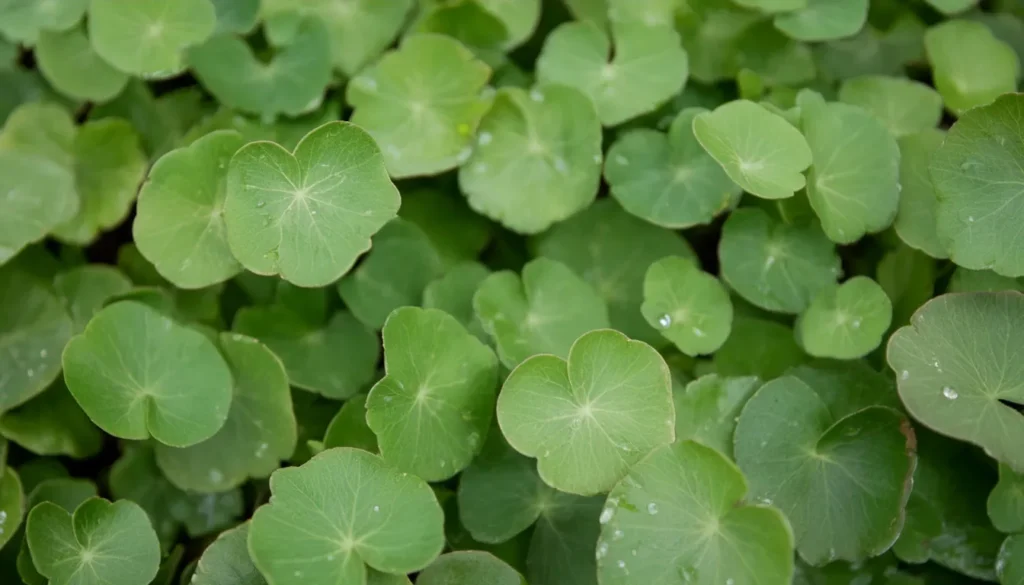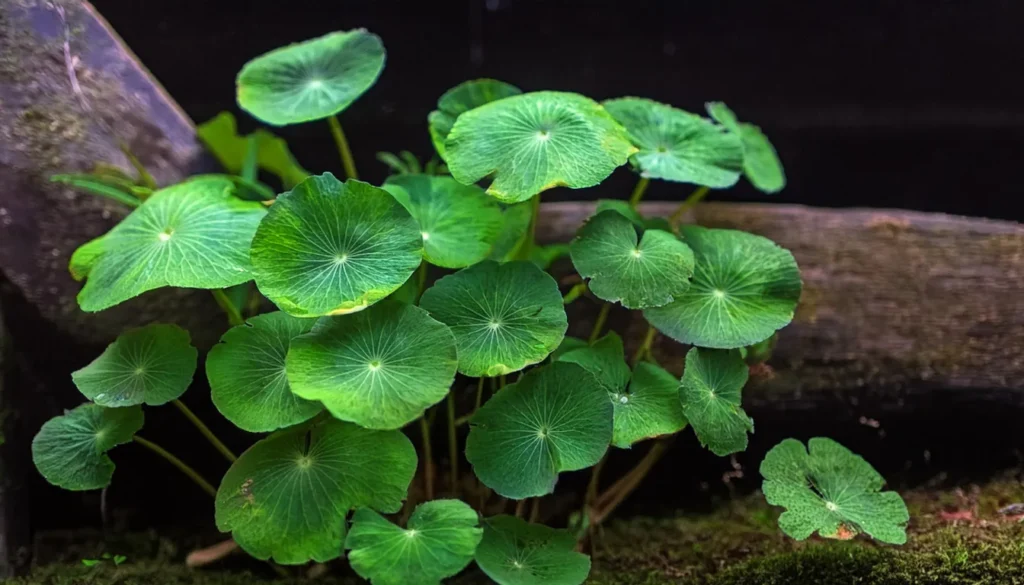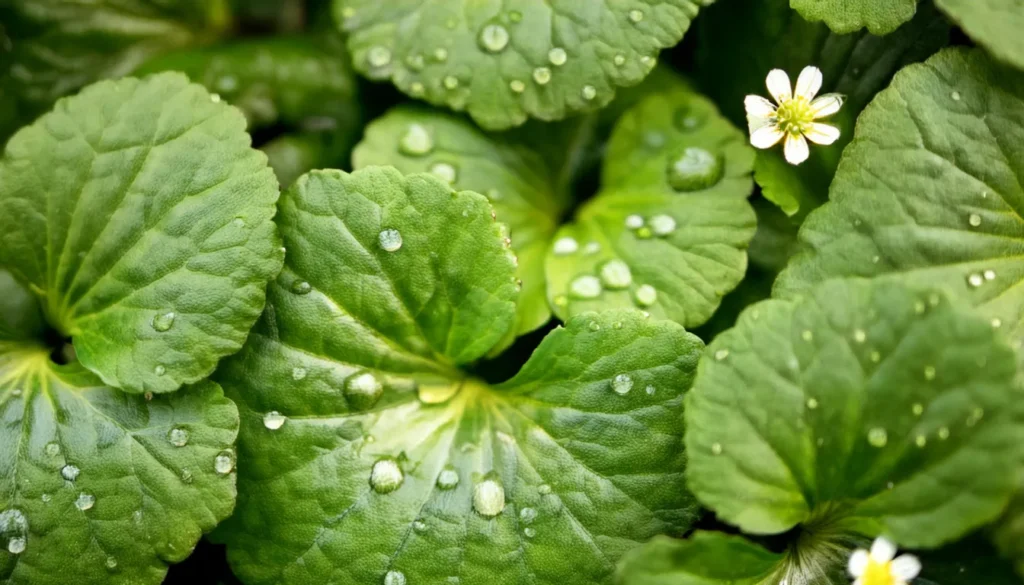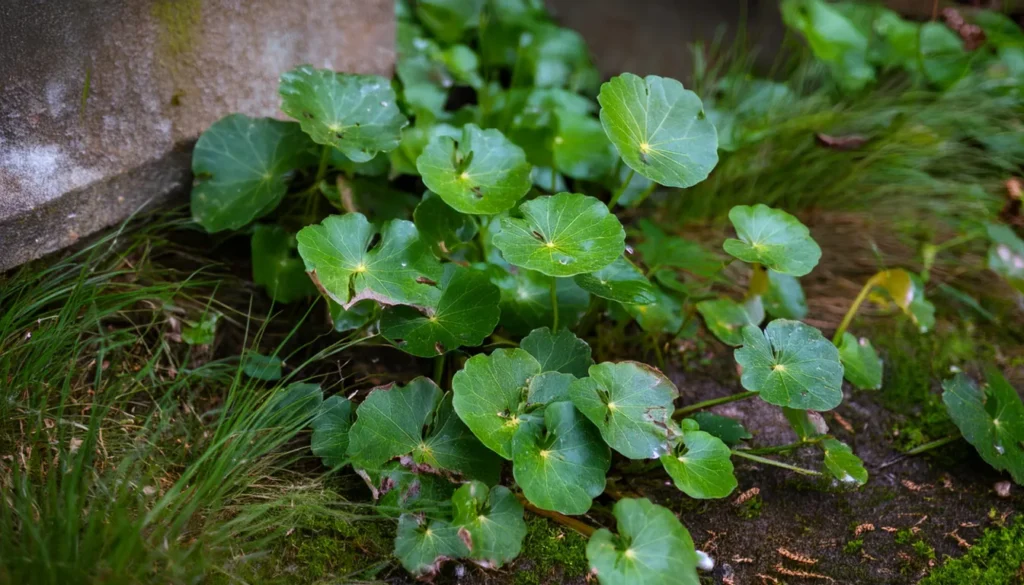Welcome to our comprehensive guide on Hydrocotyle Leucocephala, also known as Brazilian Pennywort.
As avid freshwater aquarium enthusiasts, we understand the importance of finding the perfect aquatic plants to create a vibrant and healthy underwater environment.
Hydrocotyle Leucocephala is a fast-growing plant that not only adds beauty to your aquarium but also provides numerous benefits for your aquatic ecosystem.
Whether you are a beginner or an experienced aquarium keeper, Hydrocotyle Leucocephala is an excellent choice due to its stunning appearance and low-maintenance nature.
In this article, we will delve into the world of Hydrocotyle Leucocephala and explore its characteristics, growth requirements, planting techniques, and the advantages it brings to your freshwater aquarium.

Key Takeaway
- Hydrocotyle Leucocephala, also known as Brazilian Pennywort, is a popular aquatic plant for freshwater aquariums.
- It is a fast-growing plant that provides natural aquarium decoration and creates a lush and lively atmosphere.
- Hydrocotyle Leucocephala is beginner-friendly and requires minimal care and maintenance.
- It thrives in optimal lighting and water conditions, with nutrient-rich substrate and sufficient space to spread its beautiful foliage.
- Regular pruning and propagation are essential to maintain the health and longevity of Hydrocotyle Leucocephala in your aquarium.
Quick Stats
| Attribute | Details |
| Family Name | Araliaceae |
| Origin | Central and South America |
| Height | 15-60 cm (6-24 inches), can trail or climb if allowed |
| pH Range | 6.0 – 7.8 |
| CO2 Requirement | Low to Moderate |
| Growth Rate | Fast |
| Care Level | Easy |
| Color Form | Light to Bright Green |
| Water Conditions | 20-28°C (68-82°F), adaptable to a range of water hardness |
| Max Size | Can grow indefinitely in length; leaves up to 3 cm (1.2 inches) in diameter |
| Lighting | Low to High |
| Supplements | CO2 supplementation beneficial but not necessary; benefits from liquid fertilizer |
| Placement | Mid-ground to Background; can be floated |
| Propagation | Stem cuttings |
What Is Hydrocotyle Leucocephala?
In this section, we will delve into the details of Hydrocotyle Leucocephala, also known as Brazilian Pennywort.
Freshwater aquarium enthusiasts highly seek this aquatic plant due to its unique characteristics and versatility.
- Hydrocotyle Leucocephala is a fast-growing plant with vibrant green leaves and delicate stems. Its distinctive umbrella-shaped foliage sets it apart from other aquatic plants, making it an eye-catching addition to any aquarium. The plant can reach a height of about 6-8 inches, providing a lush and dynamic aesthetic.
- One of Hydrocotyle Leucocephala’s key characteristics is its adaptability to various water conditions. It can thrive in both low and high-light environments, making it suitable for different aquarium setups and lighting preferences. This versatility also makes it an ideal choice for beginner aquarists.

Natural Habitat And Origin
Hydrocotyle leucocephala, commonly known as Brazilian pennywort or pennywort, is native to tropical and subtropical regions of the Americas, including South and Central America, as well as parts of the Caribbean.
It is commonly found growing in wetlands, marshes, and along the edges of rivers, streams, and ponds.
In its natural habitat, Brazilian pennywort typically grows emersed or partially submerged, often forming dense mats of floating vegetation.
It thrives in warm, humid climates with ample sunlight and nutrient-rich water.
RELATED: Mastering The Art Of Planting Helanthium Tenellum At Your Aquatic Lawn
Physical Characteristics
- Leaves: The leaves of Brazilian pennywort are round to kidney-shaped and have scalloped or serrated edges. They are typically bright green in color and can range in size from small to medium-sized, depending on growing conditions.
- Stems: The stems of Brazilian pennywort are long, slender, and creeping, with nodes spaced along their length. These stems can grow horizontally along the substrate or float on the water’s surface, forming dense mats of vegetation.
- Roots: Brazilian pennywort has fine, fibrous roots that anchor the plant to the substrate or float freely in the water column. These roots absorb nutrients and water from the surrounding environment, supporting the plant’s growth and development.
- Growth Habit: Brazilian pennywort is a fast-growing and highly adaptable plant that can exhibit both emersed and submerged growth forms. In its emersed form, it may produce small white flowers at the end of its stems. In aquariums, it typically grows as a submerged plant, with stems trailing along the substrate or floating on the water’s surface.
Lighting And Water Conditions
- Hydrocotyle Leucocephala thrives in moderate to high lighting conditions. For optimal growth, it recommends providing 8 to 12 hours of light per day. However, ensure that the light intensity is not excessive, as it can lead to algae overgrowth and unhealthy plant development. Consider using a timer to regulate the lighting schedule and maintain consistency.
- When it comes to water conditions, Hydrocotyle Leucocephala prefers a temperature range of 72 to 82 degrees Fahrenheit (22 to 28 degrees Celsius) and a pH level between 6.0 and 7.5. It can adapt to a wide range of water hardness, but a moderate hardness of 3 to 8 dKH is ideal for its growth.

Temperature Parameters
- Hydrocotyle leucocephala, or Brazilian pennywort, thrives in tropical and subtropical climates where temperatures are warm and consistent. In aquariums, it adapts well to a range of temperatures commonly found in tropical fish tanks.
- The optimal temperature range for Brazilian pennywort is between 68°F to 82°F (20°C to 28°C). This temperature range mimics the warm conditions of its native habitat and encourages vigorous growth.
- However, Brazilian pennywort is adaptable and can tolerate slightly cooler or warmer temperatures within reasonable limits. It is essential to maintain stable water temperatures to prevent stress and ensure the plant’s health and vitality.
Substrate Requirement
- Hydrocotyle leucocephala, or Brazilian pennywort, is a versatile plant that can thrive in various substrate conditions. While it can grow rooted in the substrate, it also adapts well to floating or loosely anchored conditions. Therefore, it does not have strict substrate requirements.
- If you choose to plant Brazilian pennywort in the substrate, a nutrient-rich substrate can provide additional support for root development and overall plant health. However, it’s essential to ensure that the substrate is loose and well-draining to prevent the accumulation of anaerobic pockets and maintain optimal conditions for root growth.
- Alternatively, Brazilian pennywort can be left to float on the water’s surface or anchored to driftwood, rocks, or other aquarium decorations using fishing line or plant weights. This allows the plant to take up nutrients directly from the water column and provides flexibility in aquascaping.
Placement Option
- Background Planting: Place Brazilian pennywort towards the back of the aquarium to create a lush green background. Allow the stems to grow vertically or trail along the back glass, providing a natural backdrop for the rest of the aquascape.
- Midground Accent: Use Brazilian pennywort as a midground accent plant to add texture and depth to the aquascape. Plant it in clusters or groups among other foreground and midground plants to create visual interest and break up open spaces.
- Floating Plant: Allow Brazilian pennywort to float on the water’s surface to create a natural canopy effect. This placement option provides shade and shelter for fish and other aquatic inhabitants while allowing the plant to absorb nutrients directly from the water column.
- Foreground Planting: While less common, Brazilian pennywort can be planted in the foreground of the aquarium to add a pop of green color and texture. Plant individual stems or small clusters along the front edge of the tank, allowing them to trail or spread horizontally across the substrate.

Recommended Tank Size
- Nano to Medium Tanks: Brazilian pennywort can thrive in smaller tanks ranging from 10 gallons (38 liters) to medium-sized tanks around 50 gallons (190 liters). In smaller tanks, Brazilian pennywort can be planted along the back or sides to create a lush background or used as a midground accent.
- Large Tanks: In larger tanks exceeding 50 gallons (190 liters), Brazilian pennywort can be planted more liberally to create dense stands or clusters. Its fast-growing nature allows it to fill in empty spaces quickly, providing ample coverage and a natural look.
- Aquascaping Goals: Consider your aquascaping goals and the overall layout of the tank when determining the appropriate tank size for Brazilian pennywort. Factor in the space available for planting, the desired visual impact, and the compatibility with other aquatic plants and hardscape elements.
Suitable Tank Mates
- Community Fish: Peaceful community fish such as tetras, rasboras, gouramis, swordtails, mollies, and platies make excellent tank mates for Brazilian pennywort. Avoid aggressive or fin-nipping species that may damage the plant.
- Bottom Dwellers: Bottom-dwelling fish like Corydoras catfish, loaches, and small plecos can safely share the aquarium with Brazilian pennywort. These fish help clean up detritus and algae, contributing to a balanced ecosystem.
- Shrimp and Snails: Dwarf shrimp species like cherry shrimp and ghost shrimp, as well as freshwater snails such as nerite snails and mystery snails, are compatible with Brazilian pennywort. They help with algae control and add activity to the tank.
- Peaceful Invertebrates: Various peaceful invertebrates like Amano shrimp, bamboo shrimp, and freshwater clams can cohabit with Brazilian pennywort without causing harm to the plant.
- Other Aquarium Plants: Brazilian pennywort can be planted alongside other aquarium plants, including stem plants, carpeting plants, and rosette plants. Its fast-growing nature makes it an excellent companion plant for creating lush, densely planted aquascapes.
RELATED: Unveiling Heteranthera Zosterifolia Planting Tips For Beginners
Nutrient Requirements
- Hydrocotyle Leucocephala is considered a nutrient-demanding plant. It requires a rich source of nutrients to ensure healthy growth.
- Adequate levels of macronutrients such as nitrogen (N), phosphorus (P), and potassium (K) are crucial. Additionally, micronutrients like iron (Fe), magnesium (Mg), and calcium (Ca) are essential for its well-being.
- To meet these nutritional needs, consider supplementing the water column with a balanced aquatic plant fertilizer.

Hydrocotyle Leucocephala Cultivation Tips
- Lighting: Provide moderate to high-intensity lighting. Brazilian pennywort thrives under bright light conditions, so use LED fixtures or fluorescent tubes to ensure sufficient illumination. Aim for a lighting duration of 8 to 10 hours per day to simulate natural daylight cycles.
- CO2 Supplementation: Consider supplementing with CO2 to promote robust growth and vibrant coloration. CO2 injection systems or liquid carbon supplements can help maintain adequate CO2 levels in the water, supporting photosynthesis and plant metabolism. While not strictly necessary, CO2 supplementation can enhance growth rates and overall health.
- Nutrient-Rich Substrate: Brazilian pennywort benefits from a nutrient-rich substrate to support healthy root development and overall growth. Use aquarium soil, nutrient-enriched gravel, or substrate additives to ensure an adequate supply of essential nutrients.
- Fertilization: Supplement with liquid fertilizers or root tabs to provide additional nutrients as needed. Brazilian pennywort is a fast-growing plant that can quickly deplete available nutrients, so regular fertilization is essential to support vigorous growth. Follow the recommended dosage instructions provided by the fertilizer manufacturer.
Plant Propagation Tips
- Stem Cuttings: Select healthy stems with several sets of leaves. Use sharp, sterilized scissors to make clean cuts just below a node (where the leaves are attached). Trim any excess leaves from the lower portion of the cutting to expose a clean stem for planting. Plant the stem cutting into the substrate, ensuring that at least one node is buried to promote root development. Keep the substrate moist and provide optimal growing conditions to encourage rooting and new growth.
- Lateral Runners: Brazilian pennywort naturally produces lateral runners that can develop roots and form new plants. Allow these lateral runners to grow and develop roots along their length. Once the runners have established roots and new growth, carefully separate them from the parent plant using sharp scissors or aquascaping tools. Plant the rooted runners into the substrate or let them float freely in the aquarium. Ensure that the new plants have sufficient light, nutrients, and water flow to support their growth.
- Encouraging Growth: Maintain optimal aquarium conditions, including proper lighting, CO2 supplementation (if available), and nutrient levels. Provide regular fertilization to ensure that the new plants have access to essential nutrients for growth. Prune and thin out the existing Brazilian pennywort to promote branching and encourage the development of new shoots and runners. Monitor for signs of stress or nutrient deficiencies and make adjustments as needed to support healthy propagation.
- Rooting Hormones (Optional): Consider using rooting hormones to promote faster root development and increase the success rate of stem cuttings. Dip the cut end of the stem cutting into a rooting hormone solution before planting it in the substrate. While not essential, rooting hormones can expedite the rooting process and improve the overall success rate of propagation.

Benefits Of Planting Hydrocotyle Leucocephala
- Brazilian Pennywort provides numerous benefits to the aquatic life inhabiting your tank. As a fast-growing plant, it rapidly absorbs excess nutrients, such as nitrates and phosphates, from the water column, aiding in maintaining optimal water quality. This natural filtration capability helps prevent the proliferation of harmful algae and promotes a healthier aquatic ecosystem.
- The dense foliage of Hydrocotyle Leucocephala provides shelter and hiding places for small fish, fry, and invertebrates, offering them a sense of security and reducing stress levels.
- This can be particularly beneficial for shy or delicate species that require refuge from aggressive tankmates or bright lighting conditions.
- In addition to serving as a visual focal point, Brazilian Pennywort also enhances the breeding success of certain fish species by providing a spawning medium and creating a natural environment that mimics their natural habitat.
- Moreover, the plant’s vigorous growth provides grazing opportunities for herbivorous fish and invertebrates, making it a valuable source of nutrition. This promotes a more natural and balanced diet for aquatic inhabitants, leading to healthier and more vibrant fish.
Fighting Off Common Pests And Diseases
- Snails: Snails can quickly multiply in the aquarium and feed on the leaves of Brazilian Pennywort. You can manually remove snail populations or introduce natural predators, such as snail-eating fish or freshwater shrimp, to control snail populations.
- Algae: Algae growth can compete with Brazilian Pennywort for nutrients and light. To minimize algae growth, regularly clean the aquarium, perform water changes, and ensure proper water circulation. You can also introduce algae-eating fish or add aquatic plants that outcompete algae for nutrients.
- Leaf Spot: Leaf spot is a fungal disease that appears as dark spots on the leaves. To prevent leaf spots, maintain clean water conditions, provide adequate lighting, and ensure good water circulation. If leaf spot is present, prune affected leaves and treat them with fungicides specifically designed for aquatic plants.

Conclusion
Hydrocotyle Leucocephala, commonly known as Brazilian Pennywort, is a versatile and fast-growing aquatic plant that brings numerous benefits to freshwater aquariums.
Its lush green foliage and cascading growth make it a popular choice for aquascaping, adding a natural and vibrant touch to any tank.
When caring for Hydrocotyle Leucocephala, it is important to ensure optimal lighting and water conditions, provide it with the necessary nutrient requirements, and allocate sufficient aquarium space.
Regular maintenance and pruning are essential to keeping this aquatic plant healthy and controlling its growth.
Integrating Brazilian Pennywort into your aquascape offers various advantages.
It serves as a natural aquarium decoration, creating a visually appealing environment.
Additionally, this plant contributes to water quality improvement by absorbing nutrients and reducing toxicity.
It also provides a natural food source, benefiting the overall health and well-being of aquatic organisms in your tank.
Frequently Asked Questions
What Are The Benefits Of Having Hydrocotyle Leucocephala In My Aquascape?
Hydrocotyle Leucocephala is a natural aquarium decoration that adds a lush and vibrant green color to your aquascape.
It also provides hiding places and food sources for fish and other aquatic organisms, promoting a natural and harmonious environment in the aquarium.
How Do I Maintain And Prune Hydrocotyle Leucocephala?
Regular maintenance includes monitoring and adjusting water conditions, such as temperature, pH, and nutrient levels, to ensure optimal growth.
Pruning involves trimming the plant regularly to prevent overgrowth and maintain a desirable shape. Removed cuttings can be planted or shared with other aquarium enthusiasts.
How Can I Propagate Hydrocotyle Leucocephala?
Hydrocotyle Leucocephala can be propagated through stem cuttings or by cultivating its seeds. Stem cuttings can be taken from the main plant and replanted to create new growth.
Seeds can be harvested and planted in a separate container until they develop into seedlings, which can then be transferred to the main aquarium.
What Issues Can Arise When Growing Hydrocotyle Leucocephala, And How Can I Address Them?
Common issues include pest infestations and stunted growth.
You can use appropriate treatments or natural pest control methods to address pests and eliminate or manage the infestation.
Stunted growth can be attributed to factors such as inadequate lighting, nutrient deficiencies, or water conditions.
Addressing these factors can help restore healthy growth in the plant.
What Role Does Hydrocotyle Leucocephala Play In Freshwater Aquarium Ecosystems?
Hydrocotyle Leucocephala contributes to water quality improvement by absorbing excess nutrients, reducing the risk of algae growth, and promoting a healthier aquatic environment.
It is also a natural food source for fish and other herbivorous aquatic organisms.
- Unveiling The Wonders Of Riccia Fluitans In Aquascapes - August 7, 2024
- Vallisneria Gigantea Var. Guide To Care And Cultivation At Home - July 31, 2024
- Vesicularia Dubyana Care & Growth Guide Tips For Beginner Gardeners - July 30, 2024
